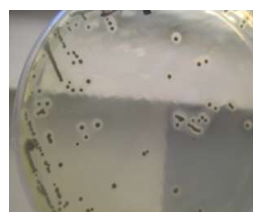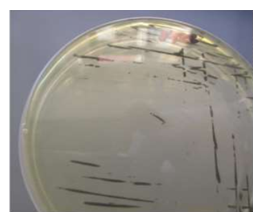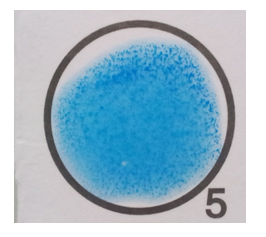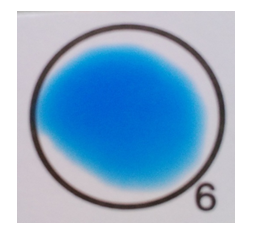Assessment of the Agglutination Test for the Identification of Staphylococcus Aureus Isolates
Article Information
Zafindrasoa Domoina Rakotovao-Ravahatra1*, Jimmy Anders Antilahy1, Joely Nirina Rakotovao-Ravahatra2, Andriamiadana Luc Rakotovao1
1Laboratory of the University Hospital of Befelatanana, Medical Biology Department, Faculty of Medicine, University of Antananarivo, Madagascar
2Doctoral School “Engineering of Industrial, Agricultural and Food Processes and Systems”, Graduate School of Agronomic Sciences, University of Antananarivo, Madagascar
*Corresponding Author: Zafindrasoa Domoina Rakotovao-Ravahatra Laboratory of the University Hospital of Befelatanana, Antananarivo, Madagascar.
Received: 17 September 2022; Accepted: 23 September 2022; Published: 11 October 2022
Citation:
Zafindrasoa Domoina Rakotovao-Ravahatra, Jimmy Anders Antilahy, Joely Nirina Rakotovao-Ravahatra, Andriamiadana Luc Rakotovao. Assessment of the agglutination test for the identification of Staphylococcus aureus isolates. Journal of Analytical Techniques and Research 4 (2022): 144-148.
View / Download Pdf Share at FacebookAbstract
Background: Staphylococcus aureus are among the most important and several pathogens in human infections.
Objectives: The objectives of this study are to evaluate the efficacy of the agglutination test in the detection of Staphylococcus aureus in the laboratory and to identify the factors associated with staphylococcal infections.
Methods: It is a prospective study of 100 isolates of staphylococci in a period of nine months from May 2021 to January 2022 in the University Hospital of Befelatanana. Results: Among of the 100 isolates of staphylococci, 49 (49%) were represented by Staphylococcus aureus. Concerning the prediction performance of the agglutination test, it has a sensitivity of 93.8%, a specificity of 100%, a positive predictive value of 100% and a negative predictive value of 94.7%. Concerning the associated factors, the men (63%) (p=0.002), the patients aged 40 to 59 years (63%) (p=0.3; NS) and with suppuration (75%) (p=0.004) were the most affected by Staphylococcus aureus. Moreover, Staphylococcus aureus was often identified in pus samples (72.4%) (p=0.0009).
Conclusion: In brief, agglutination test is a good test and can replace the standard gold test for the detection of Staphylococcus aureus.
Keywords
Agglutination; Staphylococcus aureus; suppuration
Agglutination articles; Staphylococcus aureus articles; suppuration articles
Agglutination articles Agglutination Research articles Agglutination review articles Agglutination PubMed articles Agglutination PubMed Central articles Agglutination 2023 articles Agglutination 2024 articles Agglutination Scopus articles Agglutination impact factor journals Agglutination Scopus journals Agglutination PubMed journals Agglutination medical journals Agglutination free journals Agglutination best journals Agglutination top journals Agglutination free medical journals Agglutination famous journals Agglutination Google Scholar indexed journals Staphylococcus aureus articles Staphylococcus aureus Research articles Staphylococcus aureus review articles Staphylococcus aureus PubMed articles Staphylococcus aureus PubMed Central articles Staphylococcus aureus 2023 articles Staphylococcus aureus 2024 articles Staphylococcus aureus Scopus articles Staphylococcus aureus impact factor journals Staphylococcus aureus Scopus journals Staphylococcus aureus PubMed journals Staphylococcus aureus medical journals Staphylococcus aureus free journals Staphylococcus aureus best journals Staphylococcus aureus top journals Staphylococcus aureus free medical journals Staphylococcus aureus famous journals Staphylococcus aureus Google Scholar indexed journals suppuration articles suppuration Research articles suppuration review articles suppuration PubMed articles suppuration PubMed Central articles suppuration 2023 articles suppuration 2024 articles suppuration Scopus articles suppuration impact factor journals suppuration Scopus journals suppuration PubMed journals suppuration medical journals suppuration free journals suppuration best journals suppuration top journals suppuration free medical journals suppuration famous journals suppuration Google Scholar indexed journals spectrum articles spectrum Research articles spectrum review articles spectrum PubMed articles spectrum PubMed Central articles spectrum 2023 articles spectrum 2024 articles spectrum Scopus articles spectrum impact factor journals spectrum Scopus journals spectrum PubMed journals spectrum medical journals spectrum free journals spectrum best journals spectrum top journals spectrum free medical journals spectrum famous journals spectrum Google Scholar indexed journals medical biology articles medical biology Research articles medical biology review articles medical biology PubMed articles medical biology PubMed Central articles medical biology 2023 articles medical biology 2024 articles medical biology Scopus articles medical biology impact factor journals medical biology Scopus journals medical biology PubMed journals medical biology medical journals medical biology free journals medical biology best journals medical biology top journals medical biology free medical journals medical biology famous journals medical biology Google Scholar indexed journals antibiotics articles antibiotics Research articles antibiotics review articles antibiotics PubMed articles antibiotics PubMed Central articles antibiotics 2023 articles antibiotics 2024 articles antibiotics Scopus articles antibiotics impact factor journals antibiotics Scopus journals antibiotics PubMed journals antibiotics medical journals antibiotics free journals antibiotics best journals antibiotics top journals antibiotics free medical journals antibiotics famous journals antibiotics Google Scholar indexed journals agglutination test articles agglutination test Research articles agglutination test review articles agglutination test PubMed articles agglutination test PubMed Central articles agglutination test 2023 articles agglutination test 2024 articles agglutination test Scopus articles agglutination test impact factor journals agglutination test Scopus journals agglutination test PubMed journals agglutination test medical journals agglutination test free journals agglutination test best journals agglutination test top journals agglutination test free medical journals agglutination test famous journals agglutination test Google Scholar indexed journals Staphylococcal infections articles Staphylococcal infections Research articles Staphylococcal infections review articles Staphylococcal infections PubMed articles Staphylococcal infections PubMed Central articles Staphylococcal infections 2023 articles Staphylococcal infections 2024 articles Staphylococcal infections Scopus articles Staphylococcal infections impact factor journals Staphylococcal infections Scopus journals Staphylococcal infections PubMed journals Staphylococcal infections medical journals Staphylococcal infections free journals Staphylococcal infections best journals Staphylococcal infections top journals Staphylococcal infections free medical journals Staphylococcal infections famous journals Staphylococcal infections Google Scholar indexed journals toxic shocks articles toxic shocks Research articles toxic shocks review articles toxic shocks PubMed articles toxic shocks PubMed Central articles toxic shocks 2023 articles toxic shocks 2024 articles toxic shocks Scopus articles toxic shocks impact factor journals toxic shocks Scopus journals toxic shocks PubMed journals toxic shocks medical journals toxic shocks free journals toxic shocks best journals toxic shocks top journals toxic shocks free medical journals toxic shocks famous journals toxic shocks Google Scholar indexed journals
Article Details
1. Introduction
Staphylococcus, group of spherical bacteria, the best-known species of which are universally present in great numbers on the mucous membranes and skin of humans and other warm-blooded animals. The term staphylococcus, generally used for all the species, refers to the cells’ habit of aggregating in grapelike clusters [1]. They are observed in multiple clinical situations, in community acquired infections and nosocomial infections [2]. Among staphylococci, Staphylococcus aureus (S. aureus) is one of the major human pathogens in which it is responsible for toxic shocks, food borne diseases and especially a wide spectrum of suppurative infections [3].
The laboratory of medical biology plays a very important role in the diagnosis of infections, especially bacterial infections. Indeed, the laboratory highlights the infectious agent and can determine its sensitivity to antibiotics. There are several methods for identifying S. aureus strains in the laboratory. In the laboratory of the University Hospital of Befelatanana, we used simultaneously the baird-parker culture medium, the coagulase test and the agglutination test for the identification of S. aureus strains. The identification on baird-parker culture medium represents the gold standard test [4-7]. Baird-Parker and coagulase tests require incubation at 37°C in the oven for 24 hours. However, the agglutination test gives a quick result compared to the 2 previous tests because it is obtained after 20 seconds. In this study, we tried to compare the results of Baird-Parker and agglutination tests to see if the agglutination test is as reliable as the Baird-Parker test which is the gold standard test. If the agglutination test is reliable, we can stop doing the Baird-Parker test, which is difficult to perform.
Thus, the aims of this study are to evaluate the efficacy of the agglutination test in the detection of S. aureus in the laboratory and to identify the factors associated with Staphylococcal infections in order to improve the care of the patient.
2. Materials and methods
2.1 Type and period of study
It is a prospective study of 100 isolates of staphylococci in a period of nine months from May 2021 to January2022 in the University Hospital of Befelatanana.
Procedures
In the beginning, the isolates were identified according to appearance, odor and color of bacterial colonies. Then, the identification of Gram-positive cocci on microscopic examination and the positivity of catalase confirms the diagnosis of staphylococcal infection. For the diagnosis of S. aureus infection, we performed 2 tests simultaneously. The first test is the inoculation of the strain on the baird-parker culture medium. The second is the agglutination test. Baird-parker require incubation at 37°C in an oven for 24 hours. The identification on baird-parker culture medium represents the gold standard test [4-7]. But this test requires several conditions that make it more difficult to perform compared to the agglutination tests. Indeed, a petri dish by strain is necessary for the test. In addition, we need to buy a box of baird-parker culture medium that is quite expensive. Finally, the egg yolk tellurite emulsion must be used, which will be mixed with the baird-parker agar during the preparation of the culture media. The egg yolk tellurite emulsion is necessary for the good growth of S. aureus strains. Indeed, strains of staphylococci will reduce tellurite that will become a black tellurium causing a black staining of staphylococci colonies. Similarly, there is proteolysis of egg yolk proteins, resulting in a clear (transparent) halo around the colony. The presence of this halo is specific to isolate of S. aureus (figure1 and figure 2).

Figure 1: Positive Baird-Parker test.

Figure 2: Negative Baird-Parker test.
Concerning the agglutination test, staphytect Plus is a latex slide agglutination test for the differentiation of S. aureus by detection of clumping factor, Protein A and certain polysaccharides found in methicillin resistant S. aureus (MRSA) from those staphylococci that do not possess these properties. This test is very easy to do. First, we dispense one drop of test latex onto one of the circles on the reaction card and one drop of control latex onto another circle. After, we pick up and rock the card for up to 20 seconds and observe for agglutination under normal lighting conditions. The result is positive if agglutination of the blue test latex particles occurs within 20 seconds. It identifies the isolate as S. aureus (figure 3). A negative result is obtained if no agglutination occurs and a smooth blue suspension remains after 20 seconds in the test circle. It identifies the isolate as a non-aureus Staphylococcus (figure 4).

Figure 3: Positive agglutination test.

Figure 4: Negative agglutination test.

Figure 5: Distribution of staphylococcal isolates
Study parameters
Study parameters were represented by age, gender, clinical information, sample types, Baird-Parker test, agglutination test and performance test results.
Ethical considerations
The authorization of this study by an ethics committee was not necessary because we analyzed isolates of bacteria. Nevertheless, the authorization of the director of the establishment was obtained before the data were collected in the registers. Likewise, the seizure was done anonymously to maintain confidentiality.
Data analysis
The entry and processing of data were performed on Epi-info 3.5.2 software. Proportions are presented as numbers (percent) and were compared using the chi-square test. Results were considered significant if p was 0.05 or less, with a 95% confidence interval.
3. Results
Distribution of staphylococcal isolates
Among of the 100 isolates of staphylococci, 49 (49%) were represented by S. aureus (figure 5).
Figure 5: Distribution of staphylococcal isolates
Prediction performance of the agglutination test
Concerning the prediction performance of the agglutination test, it has a sensitivity of 93.8%, a specificity of 100%, a positive predictive value (PPV) of 100% and a negative predictive value (NPV) of 94.7% (table 1).
|
Test |
Sensitivy |
Specificity |
PPV |
NPV |
|
Agglutination |
93.80% |
100% |
100% |
94.70% |
Table 1: Prediction performance of the agglutination test
Factors associated with staphylococcal infections
Concerning the associated factors, the men (63%) (p=0.002), the patients aged 40 to 59 years (63%) (p=0.3; NS) and with suppuration (75%) (p=0.004) were the most affected by S. aureus. Moreover, S. aureus species was often identified in pus samples (72.4%) (p=0.0009) (table 2).
|
Non-aureus Staphylococcus |
Staphylococcus aureus |
N |
p-value |
|||
|
n |
% |
n |
% |
|||
|
Age (years) |
||||||
|
<20 |
22 |
62.9 |
13 |
37.1 |
35 |
0.3 |
|
20-39 |
9 |
50 |
9 |
50 |
18 |
|
|
40-59 |
10 |
37 |
17 |
63 |
27 |
|
|
≥ 60 |
10 |
50 |
10 |
50 |
20 |
|
|
Gender |
||||||
|
Female |
31 |
67.4 |
15 |
32.6 |
46 |
0.002 |
|
Male |
20 |
37 |
34 |
63 |
54 |
|
|
Clinical information |
||||||
|
Genitourinary disorders |
5 |
100 |
0 |
0 |
5 |
0.004 |
|
Fever |
29 |
53.7 |
25 |
46.3 |
54 |
|
|
Pus |
7 |
25 |
21 |
75 |
28 |
|
|
Other clinical signs |
10 |
76.9 |
3 |
23.1 |
13 |
|
|
Sample types |
||||||
|
Genitourinary sample |
19 |
79.2 |
5 |
20.8 |
24 |
0.0009 |
|
Blood sample |
24 |
51.1 |
23 |
48.9 |
47 |
|
|
Pus sample |
8 |
27.6 |
21 |
72.4 |
29 |
|
Table 2: Factors associated with staphylococcal infections
3. Discussion
In this study, almost half of identified staphylococcal isolates were represented by S. aureus. Indeed, S. aureus is a major bacterial human pathogen that causes a wide variety of clinical manifestations [8]. Infections are common both in community-acquired as well as hospital-acquired settings and treatment remains challenging to manage due to the emergence of multi-drug resistant strains such as MRSA [9-10]. S. aureus is found in the environment and is also found in normal human flora, located on the skin and mucous membranes (most often the nasal area) of most healthy individuals [8]. S. aureus does not normally cause infection on healthy skin; however, if it is allowed to enter the bloodstream or internal tissues, these bacteria may cause a variety of potentially serious infections [8]. Transmission is typically from direct contact. However, some infections involve other transmission methods [11]. Thus, a good identification of staphylococci allows better management of the patient.
The evaluation of agglutination test against Baird-Parker test for the identification of S. aureus isolates showed 100% specificity and 100% PPV. Thus, there is never a false positive in the identification of strains of S. aureus when we use agglutination test. On the other hand, the agglutination test is not 100% sensitive and the negative predictive value is lowered. Indeed, when the bacterial colony is mixed with the agglutination reagent, the agglutination could not appear because the colony of S. aureus can be mixed with other bacterial colonies of different species. This situation may explain the reduced sensitivity of the agglutination test giving false negatives. In addition, agglutinations may be very small and not visible to the naked eye giving a false negative result. As a suggestion, the technician must take great care when picking up a colony of Staphylococus from the petri dish to avoid mixing this colony with other colonies of different species. If the colonies overlap, the Staphylococcus colony must be reisolated on a new petri dish and incubated for 24 hours at 37°C. After 24 hours, it is very easy to have a well-isolated Staphylococcus colony giving a good agglutination test result. Similarly, the technician should observe agglutination in a well-lit area or use a lamp to improve vision. By following these recommendations, the agglutination test can well replace the Baird-Parker test. In addition, the agglutination test requires only 20 seconds compared to 24 hours for the Baird-Parker test. This speed of the agglutination test makes it possible to carry out the antibiogram quickly and to treat the patient quickly. Thus, the care of the patient will be improved.
Concerning the associated factors, the patients aged 40 to 59 years were the most affected by bacterial infection with S. aureus but without significant difference. Thus, all age groups can be concerned. However, the literature confirms that very young children and elderly or ill patients in hospitals and nursing homes are particularly susceptible to MRSA infection, which is difficult to treat because of its resistance to most antibiotics [1]. Regarding gender, men were significantly more affected by S. aureus infection than women. Our study in 2019 was found the same result [12]. Indeed, more men work than women. Thus, they are more exposed to the risk of infection. Likewise, their toxic habits can make them more vulnerable such as tobacco and alcohol. Concerning the clinical information and the types of samples, S. aureus infections were very common in patients with suppuration with a very significant difference. Other studies have also found a high prevalence of S. aureus infections in the suppurations [13-14]. Indeed, staphylococcus is a ubiquitous bacterium frequently found on the skin. It is one of the main etiological agents of superficial and deep suppurative infections [15].
In short, the agglutination test can replace the Baird-Parker test for the identification of S. aureus isolates which are the most frequently identified bacteria representing almost half of the staphylococci. Similarly, the agglutination test is quick and improves patient care.
Conclusion
This study showed that S. aureus infections were the most frequent and the agglutination test can replace the Baird-Parker test for the identification of these isolates. Common in men and patients with suppuration, isolates of S. aureus can be identified easily by the agglutination test provided the bacterial colonies collected are pure and the observation of agglutination is made in a place well lighted.
Acknowledgments
We address our sincere thanks to the director of the University Hospital of Joseph Raseta Befelatanana for having authorized us to carry out this study. We also thank all the laboratory technicians of the University Hospital of Joseph Raseta Befelatanana for their help in carrying out the identification tests in the bacteriology laboratory.
Competing interests
Authors have declared that no competing interests exist.
References
- Britannica. The Editors of Encyclopaedia. "staphylococcus". Encyclopedia Britannica, 20 Nov. 2017 available on https://www.britannica.com/science/Staphylococcus. Accessed 20 January 2022.
- Zahlane K, Haouach K, Zouhdi M. Staphylococci: actual state of epidemiology and antibioresistance in University Hospital Center of Rabat. Maroc Médical 29 (2007): 279-285.
- Donnio P Y, Gaschet A, Cady A. Treatment news antibiotic of Staphylococcus aureus infection. Médecine Tropicale 16 (2010): 244-251.
- European Pharmacopoeia. Control of microbial contamination in non sterile products – Solution and recommended culture media. Council of Europe (2007).
- The United States Pharmacopeia (USP 31)-NF 26. Microbial Limit Tests. United States Pharmacopeia Convention Inc. Rockville, MD. USA (2008).
- ISO 6888-1 (V 08-014). October 1999. Microbiology of Foods. Horizontal method for the enumeration of coagulase positive staphylococci. (Staphylococcus aureus and other species). Part 1: Technique using the Baird-Parker agar medium (1999).
- ISO 22718. September 2009. Cosmetics – Microbiology - Detection of Staphylococcus aureus (2009).
- Lowy F D. Staphylococcus aureus infections. New England Journal of Medicine 339 (1998): 520-532.
- Centers for Disease Control and Prevention (CDC). Outbreaks of community-associated methicillin-resistant Staphylococcus aureus skin infections--Los Angeles County, California, 2002-2003. MMWR Morb Mortal Wkly Rep (2003) 52-88.
- Boucher H W, Corey G R. Epidemiology of methicillin-resistant Staphylococcus aureus. Clinical Infectious Diseases 46 (2008): 344-349.
- Rasigade J P, Vandenesch F. Staphylococcus aureus: a pathogen with still unresolved issues. Infection, Genetics and Evolution 21 (2014): 510-514.
- Rakotovao-Ravahatra Z D, Randriatsarafara F M, Milasoanjara R N, et al. Assessment of the Coagulase Test in the Identification of Staphylococcus aureus strains. Journal of Biotechnology and Biomedicine 2 (2019): 105-111.
- Kanassoua K K, Kassegne I, Sakiye E, et al. Surgical site infections in general surgery in a regional hospital in Togo. Revue Cames Santé 3 (2015): 50-54.
- Abalo A, Walla A, Ayouba G, Ndjam M. Surgical. Site Infection in Orthopedic Surgery in a Developing Country. Revue de Chirurgie Orthopédique et Traumatologique 96 (2010):112-117.
- Elazhari M, Zerouali K, Elhabchi D, et al. Antibiotic susceptibility of Staphylococcus aureus strains in the community of Casablanca (Morocco). Revue Tunisienne d’Infectiologie 4 (2010): 134-140.
